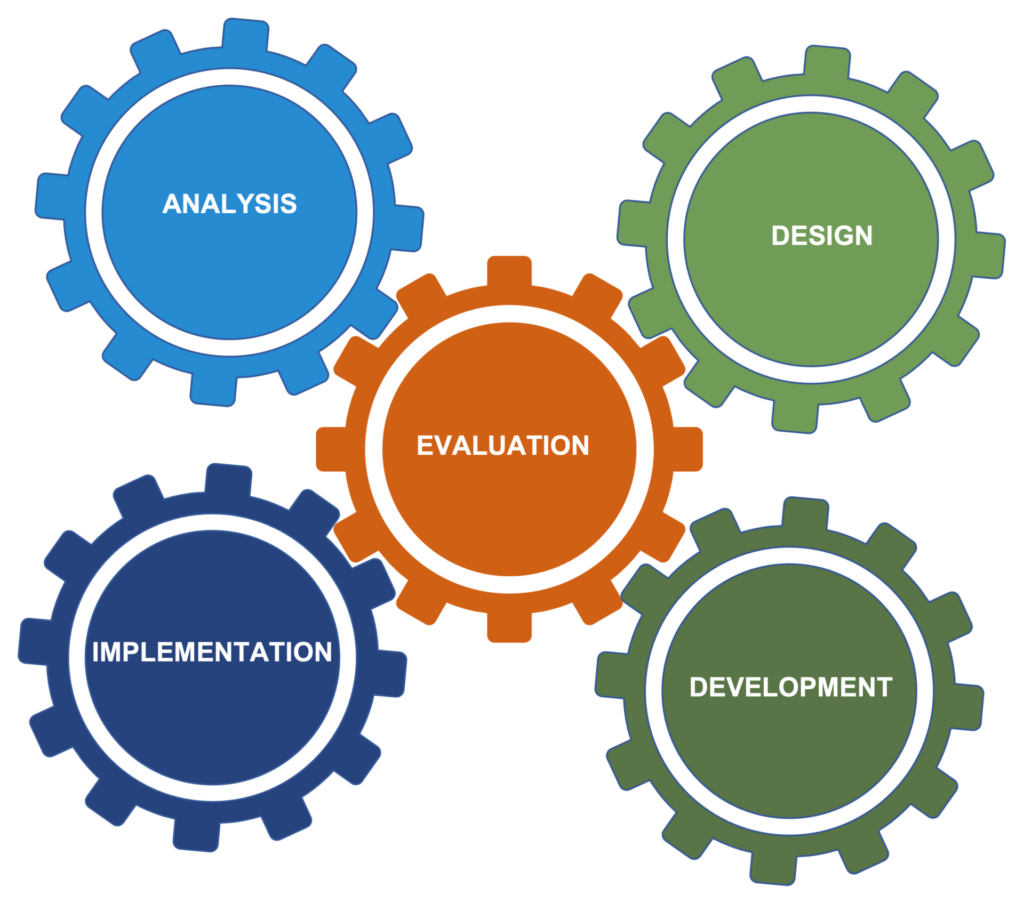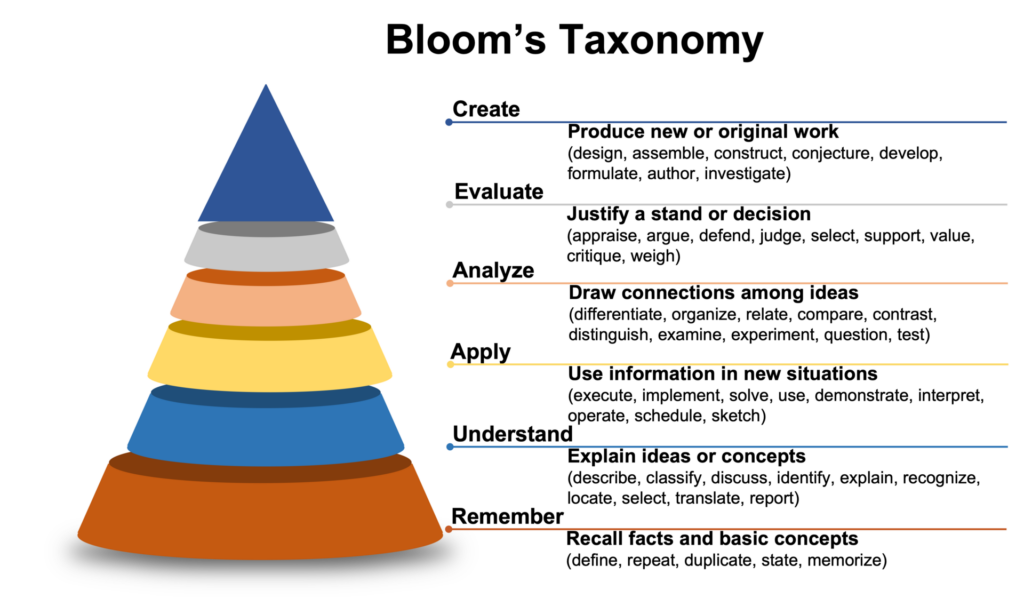Course Design and The ADDIE Model
To ensure that you are meeting the needs of your students when creating your course, it is recommended that you adopt a systematic instructional design approach. This approach involves following a clear and interconnected set of steps to create a finished product. Experts in instructional design have developed these processes with the goal of ensuring that instruction is consistent, transparent, and effective in promoting learning.
The ADDIE model is the most widely accepted instructional design system for achieving this goal. It provides a step-by-step guide for Analyzing, Designing, Developing, Implementing, and Evaluating all the necessary materials, activities, and outcomes needed to create a student-centered course that fosters an effective learning environment. The ADDIE model is particularly valuable because it emphasizes iterative review and revision throughout the design process, allowing for user feedback to be incorporated and prioritizing the needs of students, resulting in optimal learning outcomes.
The ADDIE Model: A Graphic Representation

During your journey through the course design process, you will observe that the different phases overlap and are interconnected, creating a flexible and adaptable pathway for building courses that are effective and efficient.
Phase One: Analysis
The first phase, which is called the Analysis phase, serves as the initial assessment and goal-setting stage. In this phase, you will conduct a needs assessment and identify instructional problems, objectives, the learning environment, and the existing skill sets of your students. Additionally, you will analyze educational deliverables, their various delivery options, potential learning constraints, and the timeline for completing your course and its objectives.

The Students as the Primary Focus.
You should match course components with the expected level of skill demonstrated by your students and have protocols in place to adjust the syllabus as the semester progresses and the actual skill level of your students becomes more evident. This approach accounts for various variables, such as avoiding duplication of students’ existing knowledge, customizing assignments to suit their different learning styles and experiences, and specifying the desired outcomes of the course from a student’s perspective, rather than solely from the instructor’s viewpoint.
Needs Assessment
An academic needs assessment is a tool used to systematically identify gaps between the current and desired methods and outcomes of a course. There are various ways to conduct a needs assessment, but it generally involves answering a set of questions to evaluate the relevance of the pedagogy to the students based on available data.
The first question to consider is who the students are, which involves examining their demographics, including age, gender, nationality, race, and ethnicity. Additionally, any potential accessibility, economic, or language barriers that may arise due to changes in course modality should be considered.
The second question to consider is the students’ needs, which includes identifying their learning styles, computer literacy, modality preferences (synchronous or asynchronous), and any potential environmental or socio-economic circumstances that could impact their learning if not addressed. For example, some students may require loaner laptops or calculators.
The third question to consider is the instructional goals and objectives, which involves determining what the students need to accomplish at the end of the program, the desired learning outcomes in terms of knowledge, skills, attitudes, and behavior, and the required skills, intelligence, outlook, and physical/psychological action-reaction.
The fourth question to consider is the timeline, which involves determining when the course design must be completed, how the hybrid modality affects instructional timeline and goals, and whether assignments can be reasonably completed within the allotted time in a hybrid environment or need to be altered.
Finally, the fifth question to consider is the limiting factors, which include available resources such as the college’s available technology and tech support, students’ computer literacy (as well as the instructor’s), students’ access to required technology and technical skills, time constraints, and any additional financial or support factors.
Phase Two: Design
Phase Two involves designing your course by aligning the information gathered in Phase One with the available online tools or brick-and-mortar classroom resources. This phase includes establishing the rationale behind your learning objectives, selecting assessment instruments, analyzing subject matter, planning lessons, and selecting media. The design phase should prioritize content accessibility and student success and ensure every aspect of the course falls within a logical and planned implementation strategy.

The design phase is flexible, but it’s best to track your rationale using a storyboard or written process model. Some key questions to consider during the design phase include addressing students’ needs, accessibility concerns, available tools, your teaching style, how learning will be implemented, and feedback mechanisms.
In a hybridized learning environment at CSI, your course will utilize a combination of synchronous and asynchronous methods. You will need to consider the types of tasks and learning objectives to correctly ascertain how the Blackboard Learning Management System tools, Zoom, Collaborate, existing physical classroom resources and other tools will accommodate your design. Additionally, you should consider potential economic barriers and ensure students know how to access necessary technology.
Your teaching style should consider whether it will be lecture-based or discussion-based, and what shape the central argument of your course will take. When implementing learning, you should consider what types of activities will be required and prioritized, and whether they will be collaborative, interactive, or individual. You should also determine the time frame (this is called pacing) for each activity and how learning will be facilitated. Finally, you should consider feedback mechanisms such as student surveys, in-class feedback, and grades, and determine how quickly you can review and return these materials and adjust your methods of teaching and learning if necessary.
Bloom’s Taxonomy
Bloom’s Taxonomy is a framework that helps teachers consider their students’ learning styles and needs. It is composed of hierarchical models that define learning objectives based on complexity and specificity. The focus is primarily on the cognitive domain, which involves the cognitive processes of absorbing, assimilating, and using information. The cognitive domain is divided into six levels that build on each other, with the first level being remembering and the highest level being creating. This framework is useful for course design as it helps to guide the learning process, with each level building on the previous one. Depending on the level of the course, it may focus more heavily on lower levels for foundational knowledge or higher levels for specialized knowledge.

Phase Three: Development
In Phase Three, you will begin to put the course structure together in your Blackboard classroom or any other current Learning Management System (i.e Brightspace, Moodle, etc). This involves creating and assembling pilots of the hybridized course structure (or fully online and face-to-face courses), tools, assignments, and assessments based on the needs framework you analyzed in Phase One and the brainstorming from Phase Two. You will then conduct an in-depth peer review with a team of testers to evaluate the course and make necessary adjustments.

The goal is to create a design that facilitates the greatest possible achievement of learning outcomes. During the testing phase, it is important to consider whether the testing team is effective and communicating well, whether the predicted time frame for completing assignments is reasonable, whether the materials are allowing participants to engage optimally, and whether the materials are serving their intended purpose.
It is crucial to keep in mind that testing instructor comfort with the design is ineffective in determining the comprehensibility of your course since what makes sense to an instructor may not make sense to a student. The process of creating, testing, evaluating, and adjusting should be repeated until the course is deemed fit for implementation.
Phase Four: Implementation
The fourth phase is the implementation phase, during which the course is delivered, evaluated, and adjusted based on student feedback. This includes training assistants, creating an engaging learning environment, teaching the course, and continuously responding to student feedback. The process of creating, delivering, evaluating, and adjusting will continue from the peer review stage of the development phase to the classroom in this phase. It is essential to be flexible and responsive to the needs of students and assistants during this phase.

To ensure that the design is pedagogically sound, you should consider the following questions and conclusions:
- How do students and assistants emotionally respond to the course? Are they interested, engaged, critical, or resistant?
- How quickly do students and assistants grasp the content and how much extra help do they need? Do they reach a point where they can work independently, or do they need constant guidance?
- Can the course design be customized to meet the unique needs of each student and cohort? Did you create a backup plan in case of design failure?
4. How well does the design adapt to unexpected events? Did you anticipate creator or technology errors, and how will you correct course if a tool fails?
Phase Five: Evaluation
Phase Five of the ADDIE model focuses on evaluating the effectiveness of the instructional and pedagogical framework. The evaluation process takes place throughout the ADDIE process, with formative evaluation conducted during the Development and Implementation phases and summative evaluation performed after the course is completed. The purpose of evaluation is to determine whether the course goals have been achieved and to identify areas for improvement.

To develop an effective evaluation method, it is important to determine the categories and criteria for assessing course effectiveness, the tools, timeframe, and implementation of data collection, a system for analyzing feedback and data, methods of flexible course adjustment, and methods of measuring content reliability and validity. During the evaluation process, it is important to look out for gaps and misunderstandings, content delivery according to Cognitive Load Theory, and assessment delivery.
Questions to ask during the evaluation process include whether assumptions about student needs were correct and whether any necessary adjustments were made, whether content was effectively chunked per instructional design best practices, whether assessment questions were clear, concise, and relevant to the course materials and learning objectives, and whether learning objectives were achieved. It is also important to identify any technological glitches or instructor errors that may have impacted learning outcomes and to determine how affected students were supported.



